Sponsored Post by Tamayouz Excellence Award
Don't Miss the Tamayouz Excellence Award's 2019 Roundup of Award-Winning Projects
By Tamayouz Excellence Award|
Thursday, Apr 23, 2020

Related
Tamayouz Excellence Award is an international awards program that champions architecture by celebrating projects, individuals and institutions. With seven awards that make up its program, four are project-based, including the Rifat Chadirji Prize (a thematic competition), the Dewan Award for Architecture (a thematic competition), and two graduation project awards for international and Iraqi students of architecture.
Across Tamayouz’s 2019 cycle, several projects submitted by architects from all over the world were highly recognized, particularly for its two annual thematic competitions. For both awards, the winning projects reflected their creators' understanding of context and informed responses to the programs, challenges and user needs.
The following is a roundup of seven winning projects (taken from both of Tamayouz's thematic competitions), providing an in-depth overview of the excellent work produced last year.
Despite the challenges presented by the ongoing Covid-19 outbreak, Tamayouz’s 2020 cycle is set to continue and readers can register for this year's cycle here.
Rifat Chadirji Prize
The Rifat Chadirji Prize is an annual thematic competition named after the prolific Iraqi architect Dr Rifat Chadirji. The aim of the prize is to establish an open source of ideas that tackle worldwide urban challenges. In 2019, the theme was to design a museum in Sharjah, UAE to house Barjeel Art Foundation’s extensive collection of modern Arab art.
For 2020, the theme is designing a living pedestrian bridge over the Nile River in Cairo. Read the brief here.

First Place: AIDIA Studio; Mexico City, Mexico. AIDIA Studio filled the site with a low-rise monolithic structure. As the museum sits within a semi-industrial area, the architects envisaged an introverted complex of solid appearance resembling a fortress. They proposed a porous mass, which was meticulously carved to create courtyards and passages. The concept is an immersive experience for the visitor to subtract themselves from reality.
The galleries are organized as a circuit that unfolds around the courtyards. They are laid out below street level to shield the artwork from sun exposure and thermal gains. Filtered light is introduced purposefully in specific locations, letting visitors glimpse the water features and the base of the windtowers. Here, the traditional windtower typology has been reinterpreted and reshaped into a contemporary sculpture that not only serves as a cooling device, but also adds value to the space.
The design’s roof stands out – featuring a complex geometry inspired by complex Arabic motifs, the canopy contrasts with the simple forms of the museum.

Second Place: SOLID; Cairo, Egypt The first time the architects behind Solid – Nader Moro and Sameh Zayed – came across Barjeel’s art collection, they resonated with what were the fragments of a century of artistic production from the Arab region. Each piece, they felt, told a different story of a different time. This fragmentation, which dates back to the late 19th century and stretches to the late 20th century, features works by notable Middle Eastern artists. The architects felt an urge to give the Barjeel museum the power of this fragmented collection.
The museum skyline is composed of independent volumes, highlighted by the landmark windtower. The fragmented art spaces allow for a strong integration with outdoor displays and events, while the windtower offers a new contemporary architectural discourse to the city identity.
The design encourages people to flow within a new cultural core that is linked to the rest of the city. The museum’s masterplan is open to the public and engrosses its visitors in the process of exploration and discovery of the art collection as they enter the welcoming oasis and meander through the interconnected exterior and interior spaces. The masterplan is divided into two layers: a bottom layer for the exhibition spaces and art galleries, and an upper layer for the open space activities and main terrace to the museum spaces.
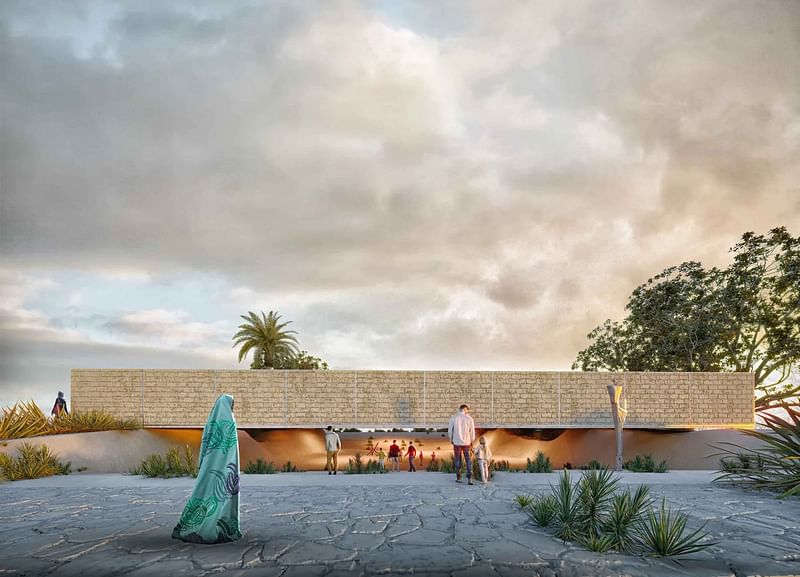
Third Place: Mohamed Hassan Elgendy; Cairo, Egypt Based on traditional roots, reflected in a contemporary envelop, the scheme features a distinctive square volume that is partially elevated from the ground, creating a public void underneath. This void fundamentally becomes part of the building and offers an informal cultural plaza within the formal boundary of the building, which will provide a new sense of dynamic interaction between the city and the art community. The void also creates a much-needed public cultural space that is resistant to the harsh desert climate of Sharjah.
The floating volume is perforated with a series of lightwells to create a naturally lit interior that is further illuminated by a square-shaped, glazed, introverted façade. This façade also provides the cultural plaza below with natural light and air ventilation. The floating perforated volume works as a contemporary, urban ‘saqifah’ for the cultural plaza – a traditional Arab latticed shed structure that was used for gatherings and events in the Gulf countries. The museum program is arranged within the elevated volume which is defined by a contemporary open plan that is human oriented, creating an interactive cultural environment that benefits from the play of light and shadow.
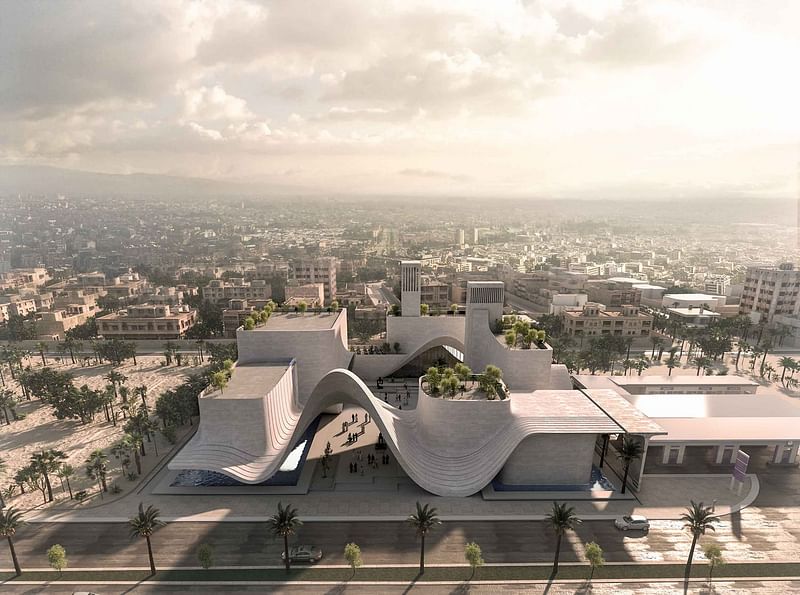
People’s Choice Award: Cell Studio; Giza, Egypt This design seeks to highlight the role of art as a storyteller, and this was realized through a number of design elements including the circulation of both the indoor spaces (by sequential flow of spaces as dictated by the dates of the artwork) and outside the museum, which integrates a public plaza inspired by the traditional Arab courtyard. The outdoor courtyard is not only ideal for cultural and artistic events, it also encourages visitors to remain connected with nature and the surrounding landscape as it is open to the sky.
Modern art is largely symbolic and expressive, and merging that with the complex political and social history of the Arab region, art and the cultural and urban identity of the Middle East remain influential and powerful. The museum’s spatial experience expresses this through transitions from the external arena through to the galleries, which are visually connected via an inner courtyard and multiple levels that lead to a viewing deck. This high point offers vistas of the courtyard and surrounding landscape, as well as views of the project in its totality. The form of the building is further informed by the abstraction of the windtower, while water features at the entrance of the museum act as a witness to the Arab history and moisten the harsh desert air.
Dewan Award for Architecture The Dewan Award for Architecture is the newest award to join the Tamayouz Excellence Award program of championing and celebrating the best of architecture in Iraq and around the world. 2019 marked the award’s second cycle, which followed the theme ‘Regeneration of Al Umma Park in Baghdad’, a cultural landmark of the city that houses iconic art pieces that narrate Iraq’s history.
For 2020, the Dewan Award for Architecture is themed ‘Youth House Complex’ in Baghdad’s Sadr City. Read the brief here.
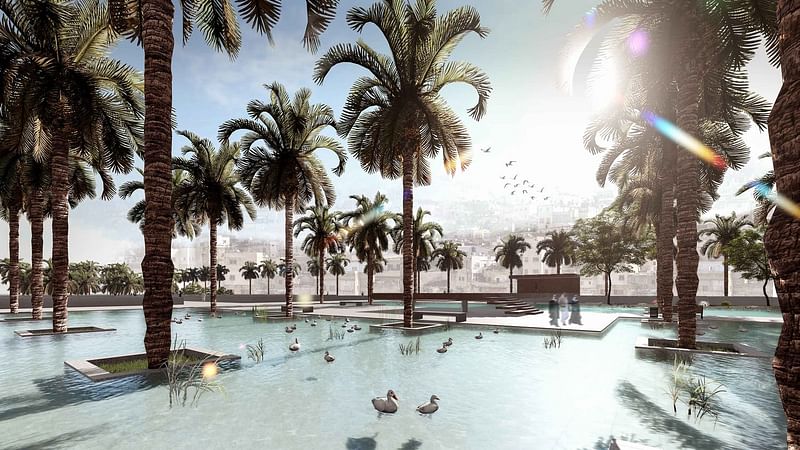
First Place: Tha’er Qub’a Consultant Architects; Amman, Jordan The Freedom Monument generated the form for Tha’er Qub’a’s Park Museum, whereby, through repetition and rotation, the huge mural turned into platforms that withhold talks and debates. Floating on a large reflective lake, these panels reflect the fragments and diversity of the Iraqi people, while being held together by the water feature, which serves as a metaphorical extension of Iraq’s rivers and a symbol of unity.
The first few tilted platforms will work as PV cells and shading devices prior to becoming horizontal planes, with each showcasing a special cultural event. Using corten steel cladding, the platforms reflect the colour of traditional Iraqi mud bricks.
The final stage of the park’s journey is the Al Umma Centre, located underground near the modern art museum. The visitors are met with a large open courtyard consisting of gathering steps that lead to The Mural of the People at Tayeran Square. The architect proposed to move the streets adjacent to the park to the lower level, which separates the pedestrian and vehicle movement. The platforms hence become hanging bridges that connect the park to the context.

Second Place: 2x1 Architects; Ankara, Turkey This project aims to reestablish a connection between the city and the planet by placing the park in a valley, and offering a place to the local community to escape from the negative elements of the city, such as noise.
The valley removes the turbidity of the surrounding city and creates a new space for the visitors that is integrated within nature. The surface, transformed into a valley and assuming the role of a public space, rests on a lower elevation that is meant to symbolize the destruction of the memory of Baghdad’s latest period – what the architects call the ‘Depression of Baghdad’.
Bridges are built over the valley in the southeast and northwest directions and pedestrian crossings are formed, thus strengthening the bond between the old and the new. The museum is located in the north end of the project area, establishing a spatial relationship with the Museum of Modern Art and the monument. The resulting area is connected to Tayeran Square and transformed into an art square. The “art axis”, which lays between Tayeran Square and Tahrir Square, is created to provide a connection to other monuments and art objects that will be built in the project area.

Third Place: Marcin Kitala; Czestochowa, Poland Marcin Kitala’s Al Umma Park revitalization proposal tells a story about interactions of people, flora and micro-climates. The design consists of more than 100 different gardens, with each maintaining different floral arrangements, various colors, textures, smells, soil, sun exposure and water features. Each combination creates distinct micro-climates or atmospheres, which visitors can experience, using all of their senses.
Greenery along the park is arranged in horizontal layers to offer different degrees of shade. However, some places have full sun exposure – there also exists sand gardens. Water is present throughout the park in all states, from ice in yakchals to ponds, pools, bogs, to salt and mist gardens. Different types of grasses, palms, fruit trees, herbs and flowers further stimulate the senses, offering rich, multisensory experiences.
The space was intended as an experimentation where visitors can touch every tree and its bark, explore what’s hidden behind every stone or walk into every pond. Thus, this design encourages spontaneous experiences between the landscape and those visiting. Small divisions throughout echo the structure of Baghdad’s urban tissue in the form of a modern grid and easily blend with it. A strict border between city and park is avoided. The new Al Umma Centre sits between the gardens, flowing through them, and negotiating human creations with those of nature.

RELATED NEWS Tamayouz Excellence Award recognizes Dana AlAmri, Dr. Zeynep Celik, and Shahira Fahmy as winners of the 2019 Women in Architecture and Construction Award

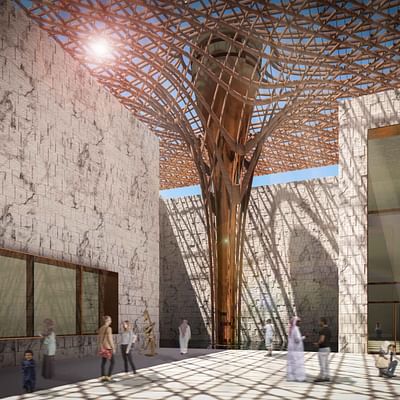
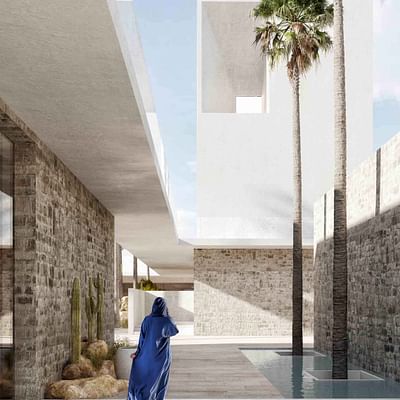
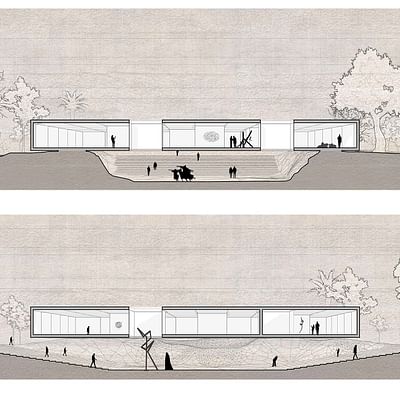
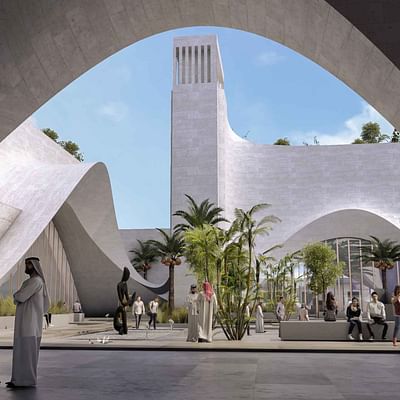


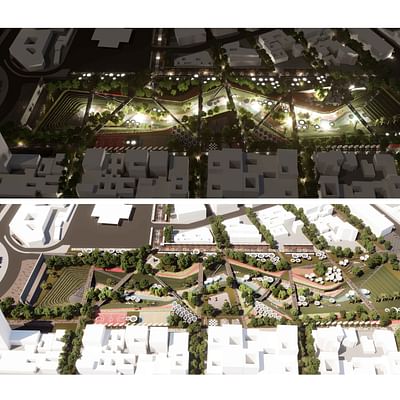


Share
0 Comments
Comment as :